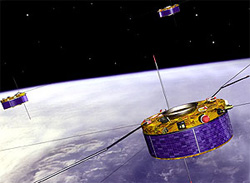Recent Stories
- Businesses urged to tap into science and technology young talent
- Digital relay baton enables remote crowd cheering of athletes
- Health Innovation Campus moves a step closer
- £7.1 million R&D boost for North West businesses
- Centre of excellence created for the next industrial revolution
- Artificial intelligence toolkit spots new child sexual abuse media online
- Strategic partnership set to help plug cyber security skills gap
- What your choice of smartphone says about you
- InfoLabTree: Discover the Story
- novi.digital Launch Event - 'An Event to Help Businesses Grow Online'
RSS Feeds
RSS feeds can deliver the latest InfoLab21 news and events direct to your browser without you having to visit the website.
In most browsers you can click on an RSS link and choose to subscribe to the feed to add it to your favourites or bookmarks.
International Satellite Workshop
Story supplied by LU Press Office
 Artist's impression of Cluster spacecraft (Image credit: ESA)
Artist's impression of Cluster spacecraft (Image credit: ESA)
Researchers from the Department of Communication Systems are part of an international team of scientists trying to predict 'space weather' in an attempt to prevent global power failures and damage to satellites.
The researchers from Europe, the USA, China and the UK are investigating measurements from satellites orbiting the Earth together with data from a worldwide network of ground-based experiments.
The aim is to try to predict the effects of geomagnetic storms, when electrically charged particles from the sun enter the Earth's atmosphere.This can damage defence and telecommunications satellites and overload electricity networks on the ground, causing power failures across whole continents. Aircraft may also have to be diverted because of the risk of high doses of radiation.
Dr Jim Wild, from the Space Plasma Environment and Radio Science group at InfoLab21, organised the international workshop.
He said: "This research is very relevant to today's technologically dependent society where a geomagnetic storm can play havoc with radio communications. A large part of Canada once lost power because of this and it can also mean aircraft being diverted, so using up more fuel on longer routes and delays for passengers. If we could predict when these storms were likely to occur, we could plan ahead."
The researchers are studying data from the four-satellite 'Cluster', operated by the European Space Agency, and the two-satellite 'Double Star', operated by the ESA and the China National Space Administration.
Dr Wild said: "The satellites are designed to study the magnetosphere - the region of near-space dominated by the Earth's magnetic field - and investigate the electromagnetic connection between the sun and Earth.
"Disturbances in this coupling to the Sun - often called 'space weather' - can lead to electrically charged particles of solar origin entering the upper layers of the Earth's atmosphere.
"The most striking natural effects of space weather are the Aurora Borealis or 'northern lights', but a large influx of charged particles can damage Earth-orbiting satellites and play havoc with radio communications.
"Electrical currents flowing through the upper atmosphere can also overload electricity network distribution networks on the ground."
By combining data from instruments such as ionospheric radars, magnetometers and auroral imagers with satellite data, the scientists are trying to find out when this is likely to happen.
Dr Steve Milan from Leicester University said: "The goal is to predict how the sun will behave and shut down satellites on those days to save them being knocked out because just one satellite costs hundreds of millions of pounds."
Professor Yang Huigen from the Polar Research Institute of China said it was good to share information.
"We need to collaborate because we are scientists in different countries, with different instruments and different sets of data and we need to make sense of these."
Fri 08 September 2006
Associated Links
- China National Space Administration (CNSA) - English version
- Cluster, Double Star and Ground-Based Workshop - conference website
- ESA Cluster project - The Cluster mission is currently investigating the small-scale structure (in three dimensions) of the Earth's plasma environment, such as those involved in the interaction between the solar wind and the magnetospheric plasma, in global magnetotail dynamics, in cross-tail currents, and in the formation and dynamics of the neutral line and of plasmoids
- ESA Double Star project - Double Star follows in the footsteps of ESA's ground-breaking Cluster mission by studying the effects of the Sun on the Earth's environment. Conducting joint studies with Cluster and Double Star increases the overall scientific return from both missions
- Space Plasma Environment And Radio Science (SPEARS) Group - combining research of the Earth's space environment, through observations of high-latitude phenomena, with innovative design and operation of ground-based space research facilities



